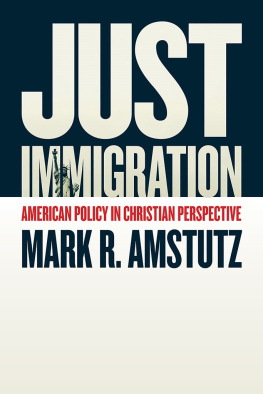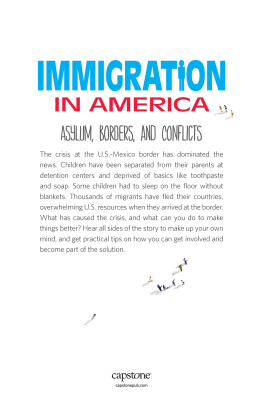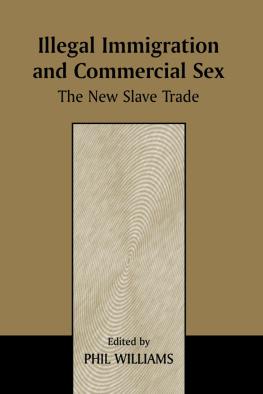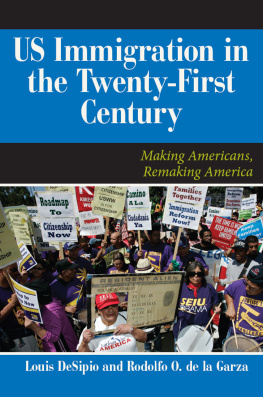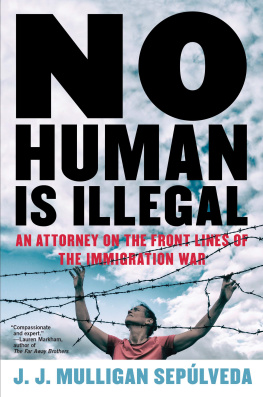GETTING IMMIGRATION RIGHT
GETTING IMMIGRATION RIGHT
WHAT EVERY AMERICAN NEEDS TO KNOW
EDITED BY DAVID COATES & PETER SIAVELIS
Foreword by Alejandro Portes

Copyright 2009 by David Coates and Peter Siavelis.
Published in the United States by Potomac Books, Inc. All rights reserved. No part of this book may be reproduced in any manner whatsoever without written permission from the publisher, except in the case of brief quotations embodied in critical articles and reviews.
Library of Congress Cataloging-in-Publication Data
Getting immigration right: what every American needs to know / edited by David Coates and Peter Siavelis; foreword by Alejandro Portes.1st ed.
p. cm.
Includes bibliographical references and index.
ISBN 978-1-59797-264-2 (hbk.: alk. paper)ISBN 978-1-59797-265-9 (pbk.: alk. paper)
1. United StatesEmigration and immigration. 2. MexicoEmigration and immigration. 3. Illegal aliensUnited States. 4. ImmigrantsUnited States. I. Coates, David, 1946 II. Siavelis, Peter.
JV6465.G48 2009
325.73dc22
2008055829
Printed in the United States of America on acid-free paper that meets the American National Standards Institute Z39-48 Standard.
Potomac Books, Inc.
22841 Quicksilver Drive
Dulles, Virginia 20166
First Edition
10 9 8 7 6 5 4 3 2 1
FOREWORD
POLICIES AND PREACHINGS THAT BACKFIRE
It is by now commonplace in the field of immigration to note that periods of high migration inevitably trigger a nativist reaction in the form of restrictionist policies, xenophobic pamphlets, and generalized anti-immigrant rhetoric. The current situation is no exception, with the qualification that the anti-migrant and, specifically, anti-Hispanic rhetoric is reaching unexpectedly shrill levels. A reason for this is that migration, primarily from Mexico and largely unauthorized, seems unstoppable: it continues at high levels year after year despite massive investments in deterrent technology and in the Border Patrol; the much touted border fence is still to show any capacity to stem the flow.
In this book, David Coates and Peter Siavelis have assembled a collection of contributions addressing the complexity of contemporary U.S.-bound immigration, with an emphasis on Mexico. With admirable balance, they have included chapters representing different political and ideological positionsfrom those that decry the stigmatization and victimization of migrant workers to those that decry the presence of migrants in the country and call for their prompt removal. This commendable eclecticism seeks to bridge the dialogue of the deaf that debates on American immigration policy have become and cast new light on those features of the situation that really make a difference.
In these introductory lines, I seek to contribute to the enterprise by highlighting four such features. In my view, each must be taken into account if the present impasse on what to do about immigration is to be overcome. Unlike much of the recent literature on the topic, these four points are not prescriptivethat is, focused on oughts, musts, and must notsbut analytic, with an emphasis on what the research literature tells us are the facts on the ground:
1. The current immigration situation is largely the countrys own doing. American policies toward major sending countries in the past have set the stage for the present inflows.
2. Attempts to suppress those inflows by force backfire, leading to consequences that are commonly the opposite of those intended.
3. Mass Mexican migration to the United States will end.
4. The present foreign-born population poses no threat to the nations linguistic and territorial integrity, but the present nativist offensive can lead to self-fulfilling prophecies.
In the course of a brief introductory essay, it is impossible to document each of these points in detail. I will limit the exposition to a synthesis of results buttressing each fact and refer the reader to the pertinent literature. It is well established by now that migration decisions do not occur as isolated cost-benefit calculations, but rather in the context of preexisting relations between sending and receiving nations. Obviously, the greater the cultural and economic influence of the stronger nation on the weaker, the more likely migrant outflows will direct themselves toward the place from where those influences emanate. This is the reason migration from former colonies directs itself overwhelmingly to the old colonial powers.
The United States has long exercised an overwhelming cultural and economic hegemony over its immediate periphery in Mexico, Central America, and the Caribbean Basin. Unsurprisingly, these areas are the major sources of low-skill labor for American farms and industries.
It is a regular feature of American policy debates to be largely oblivious to the historical forces shaping contemporary events. This is certainly the case of current immigration discussions, where the surge of Mexican migrant labor in recent years is debated without regard to the historical sequence that led to it. While it may be too late to erase NAFTAs effects, clear awareness of its role in shaping what is now taking place at the border would be a healthy antidote to one-sided interpretations and emotion-laden policy blueprints.
The same kind of historical amnesia underlies attempts to suppress the outflows produced in countries of origin by past American hegemony with force at the border. A number of studies have shown that repression does not work and that it actually backfires: instead of stemming the unauthorized movement across the U.S. southern border, heightened repression has succeeded in keeping the unauthorized population bottled up on the American side. Instead of returning to Mexico after a stint of labor in U.S. agriculture or industry, as most migrants used to do, they now remain here to avoid the increasing costs and difficulty of new crossings. Put differently, the fence does not secure the border, it simply disrupts the previous circular labor flow that worked for the benefit of both countries.
As a corollary of this situation, formerly temporary and now permanent unauthorized migrants tend to move out of agriculture and into new locations in search of better employment. This is the reason behind the movement of this labor force out of the West and Southwest, where crops now rot in the field while growers increasingly claim that they cannot find enough workers to do harvest work.
In a more optimistic vein, it is possible that, notwithstanding NAFTA, Mexico will find a path toward sustained economic development in the future. The experience of southern European countries during the 1970s and 1980s indicates that a few years of rapid growth plus good prospects for the future suffice to bring migrants home and to remove most incentives for others to start the journey. With some luck, Mexico will follow the same path, but even if this outcome were not to materialize, demographic forces already in place will be enough to end mass migration by 2030 at the latest. Detractors of the present labor flow from south of the border may reconsider what they wish for. With this conveniently near source coming to an end, it will be interesting to see how and where labor-intensive sectors of the American economysuch as agriculture, construction, and servicesmanage to secure their vital labor supplies in the future.
Last, the country should consider itself lucky about the outlooks of the various components of its foreign-born population. Despite the fears and accusations of nativists, the fact is that the overwhelming majority of this population shows every sign of wishing to assimilate to American society and that they evince far more acceptance than criticism of American institutions. In contrast with Europe, where some foreign residents routinely challenge the Wests decadent ways and seek to keep their children from assimilating or intermarrying, no such thing happens in the United States. Because of the pervasive American influence in their country, Mexican immigrants are presocialized on what to expect on this side of the border. Once here, they seek to integrate socially and economically as best they can and, especially, to further the upward mobility of their children.
Next page



